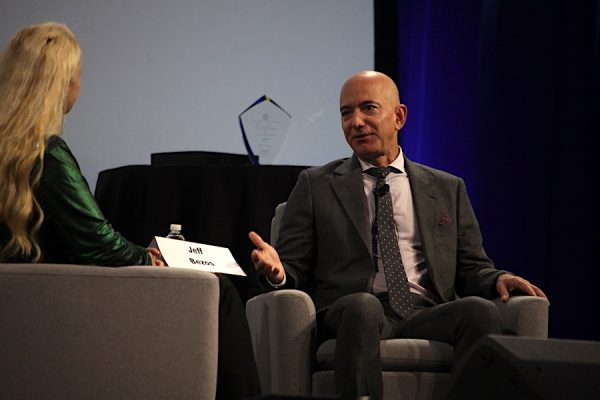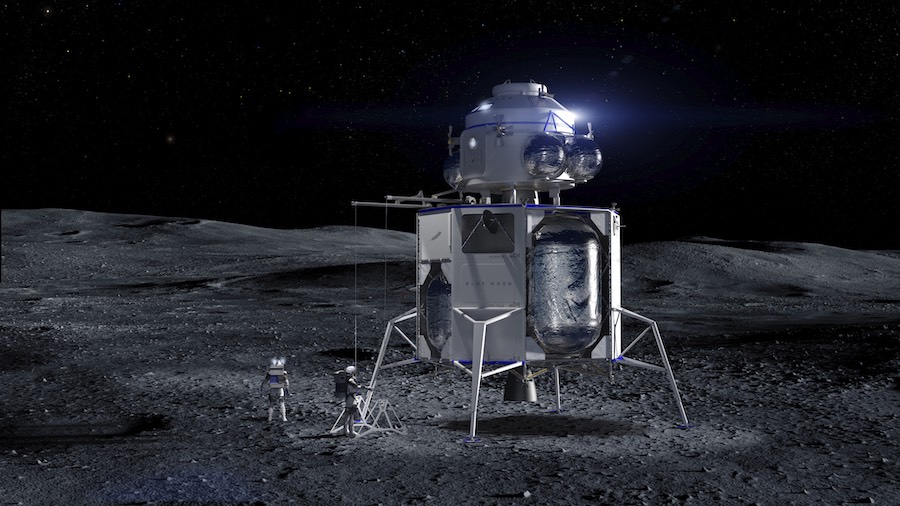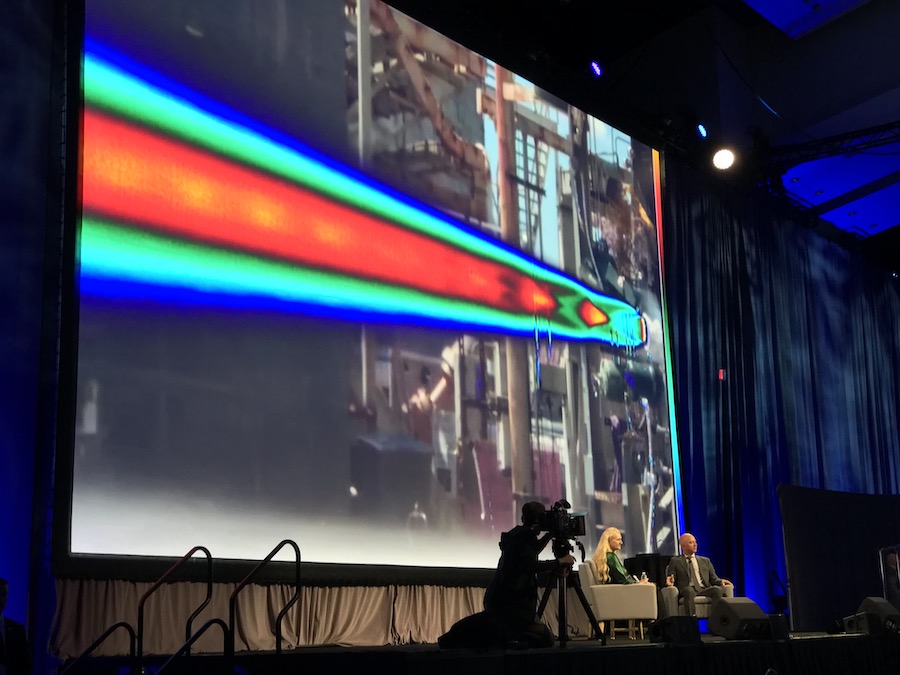Bezos says space industry stalwarts will help Blue Origin build moon lander – Spaceflight Now

Blue Origin has partnered with Lockheed Martin and Northrop Grumman to build elements of the company’s human-rated lunar lander, and Draper will lead development of the lander’s avionics and guidance systems, with an aim to be ready to land a crew on the moon by 2024, company founder Jeff Bezos announced Tuesday.
In the first major update on the company’s lander program since May, Bezos said Blue Origin has assembled a “national team” of aerospace contractors to develop, build and fly the three-stage spacecraft, which is based on Blue Origin’s previous work on the Blue Moon landing system.
“Blue Origin is the prime contractor, Lockheed Martin is building the ascent stage, Northrop Grumman is building the transfer element and Draper is doing the GNC (guidance, navigation and control),” Bezos said Tuesday at the International Astronautical Congress in Washington. “We could not ask for better partners. Blue Origin, in addition to being the prime, is going to build the descent element.”
Blue Origin is competing for a NASA contract to develop a crewed lunar lander, or Human Landing System, for the Artemis program, which aims to return astronauts to the surface of the moon by the end of 2024.
During his presentation Tuesday, Bezos emphasized that bold ambitions in space require the support of an industry, and not individual companies.
“This is a national team for a national priority,” said Bezos, the billionaire founder of Amazon and Blue Origin. “I could not be more excited to be doing it with these partners. This is the kind of thing that’s so ambitious that it needs to be done with partners. This is the only way to get back to the moon fast, and this time … we’re not going back to the moon to visit, we’re going back to the moon to stay.”
The three-element lander’s descent stage will be powered by Blue Origin’s throttleable BE-7 engine, which burns super-cold liquid hydrogen and liquid oxygen propellants. The Northrop Grumman-made transfer vehicle will also use the BE-7 engine, Bezos said.
While Blue Origin did not confirm plans to use NASA’s planned Gateway station in lunar orbit, the inclusion of a transfer module indicates the company intends to use the the mini-space station as a staging base for landing missions. Under NASA’s approach, astronauts will lift off from the Kennedy Space Center in Florida inside an Orion crew capsule on top of the Space Launch System heavy-lift rocket, then dock with the Gateway and board their moon lander.
The transfer module would guide the lander from the Gateway’s high lunar orbit closer to the moon, where the landing module will begin a powered descent to the surface.

Bezos did not discuss the propulsion system for the reusable ascent module, made by Lockheed Martin, where astronauts will ride during the lunar landing and the launch off of the moon. Lockheed Martin will “leads crewed flight operations and training” for the lander, and a company spokesperson said the ascent module will incorporate technology Lockheed Martin has developed for the Orion crew capsule.
The reusable ascent module element will be capable of multiple trips to and from the moon.
“Lockheed Martin has been honored to help NASA explore space for more than 50 years, providing deep space robotic missions, planetary landers, space shuttle heritage and the Orion exploration spacecraft,” said Rick Ambrose, executive vice president for Lockheed Martin’s space business. “We value Blue Origin’s thoughtful approach to developing human-rated flight systems, and are thrilled to be part of a national team with this mix of innovation and experience. We look forward to safely and sustainably returning our nation to the surface of the moon by 2024.”
“Lockheed Martin is, as far as I know, the only company that actually lands on the surface of Mars,” Bezos said. “They are unbelievably competent in space. They are experts in life support systems, so to have their expertise on the ascent element is a really big deal.”
Northrop Grumman, through its predecessor Grumman Aircraft Engineering Corp., built the Apollo lunar module that performed six successful landings on the moon with astronauts from 1969 through 1972.
“We are one step closer to meeting NASA’s goal to get the first American woman and the next American man to the surface of the moon by 2024,” said Frank DeMauro, vice president and general manager of Northrop Grumman’s space systems division. “This team brings the best technical and program talent together in the industry to deliver on NASA’s ambitious timeline.”
“Draper is doing the guidance and control, an incredibly complex job for landing on the moon, especially when you want to do a precision landing. Of course, they did that for the original Apollo program way back, but today it will be done in a completely new way,” Bezos said.
The Draper guidance system will use “computer vision” to perform precision landings on the moon using landmarks for navigation, according to Bezos.
“When the nation needs precision guidance, it calls on Draper,” said Kaigham Gabriel, president and CEO of Draper. “We guided Apollo to the moon and back nearly 50 years ago. We’re ready to do it again with the Blue Origin team for Artemis.”

Bezos also updated test achievements on the new BE-7 engine destined to fly on the lunar lander. The engine, which produces up to 10,000 pounds of thrust, has logged 13 minutes of run time since June, with a longest continuing firing of three minutes.
NASA’s deadline for industry proposals for the Human Landing System is Nov. 1. The landers will be developed, owned and operated commercially. NASA plans to select up to four companies for study contracts late this year or in early 2020, then down-select to two contractor teams in late 2020 to proceed with full development of a human-rated lander. Agency officials will later decide which of the two development teams will attempt the first landing in 2024, followed by a second landing mission in 2025.
In the interest of rapid development, NASA has also relaxed requirements for the early human-rated lunar landers to be reusable. NASA eventually wants to reuse landers on missions ferrying astronauts between the moon’s surface and the Gateway space station in lunar orbit, where the spacecraft could be refueled for multiple landings.
NASA is not planning to conduct an unpiloted demonstration of the lander without astronauts on-board before committing a human crew to a descent to the moon, and the agency will not require the initial set of commercial landers to be based at the Gateway.
NASA has limited the time for companies to submit their proposals to one month.
“Thirty days,” said Marshall Smith, NASA’s director of human lunar exploration programs, during a presentation to a NASA Academies’ advisory board last month. “We know it’s crazy, but so is 2024, I suppose. So we’re all working very fast.”
Email the author.
Follow Stephen Clark on Twitter: @StephenClark1.






